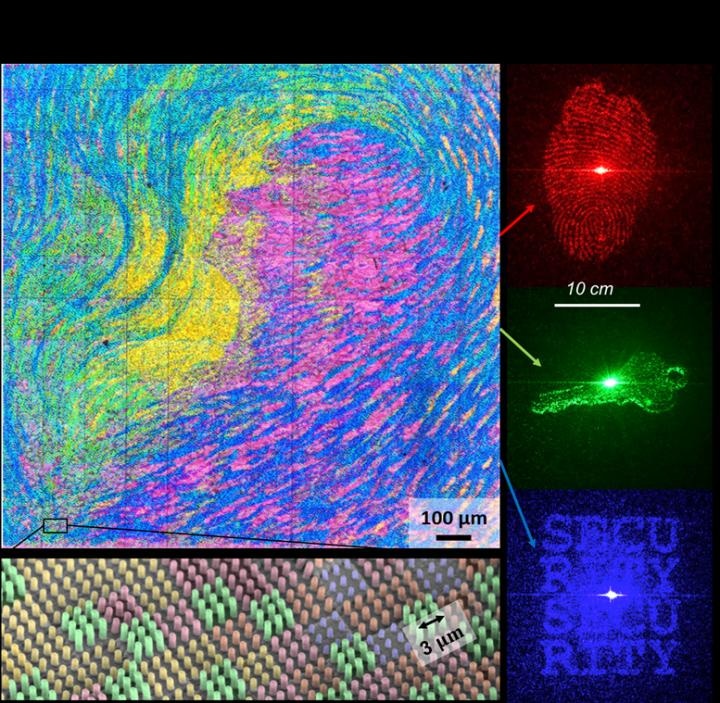Jan 9 2019
A new kind of anti-counterfeiting device that can be helpful in counterfeit deterrence of main documents like banknotes, passports, and identity cards has been developed by researchers at the Singapore University of Technology and Design (SUTD).
 Enhanced optical security provided by a six-color holographic color print. (Image credit: SUTD)
Enhanced optical security provided by a six-color holographic color print. (Image credit: SUTD)
The research group led by Associate Professor Joel Yang displayed an optical device known as “holographic color prints” that looks like an ordinary color print under white light, but when illuminated with laser pointers, it projects up to three different images onto a distant screen.
In contrast to regular diffractive optical elements that have a frosted-glass look and project only single images, these innovative holographic color prints can be a stronger deterrent to counterfeiters while looking attractive at the same time. Furthermore, the prints comprise nano-3D-printed polymer structures and find specific application in optical document security.
Counterfeiting is a great threat in everyday life, and a report from Credence Research estimates that the global anti-counterfeiting industry will reach over US$ 357 billion by 2026. Anti-counterfeiting products are vital and necessary for safeguarding products and documents. The most widely known anti-counterfeiting products are based on holograms that are ubiquitous and found on, for example, medicine bottles, electronic device package boxes, and surfaces of bank cards. However, since these anti-counterfeiting hologram products only modulate the phase of light, they are easily copyable.
The research team at SUTD created a new kind of anti-counterfeiting device, that is, holographic color printing, which modulates the phase as well as the amplitude of light. Under ambient white light, holographic color printing displays a colored image by tuning the amplitude of light, whereas under red, green, or blue laser illumination, it projects up to three different holograms. This achievement was realized by engineering an innovative of nanostructured pixel strategically arranged on a plane. Each pixel functions like a speed bump (phase control) and road blocks (amplitude control) for light. The dual function of holographic color printing prevents counterfeiting and improves security.
Associate Professor Joel Yang revealed that the color pixels of the device are produced by placing structural colored filters on top of phase plates. The amplitude of light was modulated by using nanostructured posts of varying heights as structural colored filters. The researchers created a computer algorithm that takes multiple images as its input and produces an output file that establishes the positions of various phase and colored filter elements. Then, by using a nanoscale 3D printer, the holoscopic print was designed. The researchers employed art painting Perfume (1910) of Luigi Russol as a color print that can be viewed under ambient white light. Polymerized cuboids of different thicknesses are employed to modulate the phase plates and create three multiplexed holograms, projected as a green key, a red thumbprint, and blue lettering that reads “SECURITY.” All of these images were embedded within a single print.
The relationship of holograms in combating counterfeiting is analogous to antibiotics against infections. Every so often, new technology is needed to deter counterfeiters as the old fashioned holograms become easier to copy. For the first time, multiple holograms that are color selective are 'woven' into a colorful image using advanced nanofabrication techniques. We are hopeful that these new holographic color prints are user-friendly but counterfeiter unfriendly: They are readily verified but challenging to copy, and can provide enhanced security in anti-counterfeiting applications.
Joel Yang, Associate Professor, Singapore University of Technology and Design.
This study titled “Holographic Colour Prints for Enhanced Optical Security by Combined Phase and Amplitude Control” was published in Nature Communications on January 3rd, 2019.